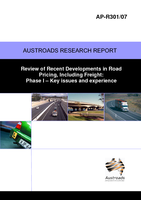Freight

Review of Recent Developments in Road Pricing, Including Freight Phase 1: Key issues and experience
- Publication no: AP-R301-07
- ISBN: 1 921139 89 7
- Published: 24 January 2007
- PDF (free) Download
This study reviews recent developments in road pricing for managing road travel demand and congestion, and identifies potential pricing mechanisms to facilitate freight modal choice based on marginal social costs including environmental and other externalities. The report presents a literature review that identifies key issues related to road pricing principles, objectives, applications, impacts, technologies, and lessons. It is also a working document that provides a platform for subsequent work in this area. A review of international road pricing experience undertaken as part of the study reaffirms the view that public acceptance is critical to the implementation of road pricing. Road pricing is increasingly viewed as a concept that offers considerable benefit to society through its potential to improve road transport efficiency and reduce congestion and other impacts such as air pollution and noise. However, a definition of the precise form of congestion and measurement techniques that estimate the actual amount of congestion and the appropriate charge required, are either lacking or difficult to establish.
- AP-R301/07 Review of Recent Developments in Road Pricing, Including Freight: Phase I – Key issues and experience
- Austroads membership
- 1. INTRODUCTION
- 2. DEFINITIONS
- 2.1. Road pricing
- 2.2. Congestion pricing – marginal pricing for localised congestion
- 2.3. Road taxes
- 3. OBJECTIVES OF ROAD PRICING
- 3.1. Infrastructure financing
- 3.2. Congestion and other externalities relief
- 3.3. Other variants of travel demand management
- 4. THEORY AND MEASUREMENT ISSUES
- 4.1. Measuring congestion
- 4.2. Measuring the cost of congestion
- 5. TYPES OF ROAD PRICING SCHEMES
- 5.1. Link-tolling (charging for linear section of infrastructure)
- 5.2. Congestion charging
- 5.3. Heavy vehicle charging
- 6. DESCRIPTIONS OF INTERNATIONAL SCHEMES
- 6.1. Type of scheme and objectives: successes and failures
- 7. PUBLIC ACCEPTANCE
- 7.1. Hypothecation
- 7.2. Public acceptance of toll roads in Norway
- 7.3. Public acceptance of urban pricing in the UK
- 7.4. Other opinion surveys
- 7.5. Equity
- 7.6. Education and marketing of road pricing schemes
- 8. ROAD PRICING TECHNOLOGY
- 8.1. Tolling methods
- 8.2. Technology issues
- 8.3. Australian context
- 8.4. Key issues regarding technology
- 9. APPLICATION OF ROAD PRICING IN AUSTRALIA AND NEW ZEALAND
- 9.1. Objectives – congestion relief, efficient movement of freight
- 9.2. Institutional issues
- 9.3. Opportunities/barriers to introduction in Australasia
- APPENDIX A INTERNATIONAL TOLL ROAD DEVELOPMENT ISSUES/BEST PRACTICES
- Detail of issues
- REFERENCES
Related publications
WEB-AP-R677-22
Latest Freight News
